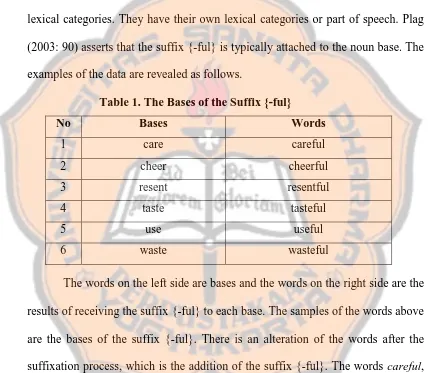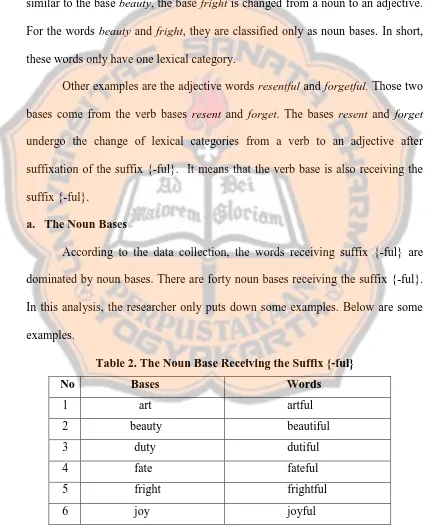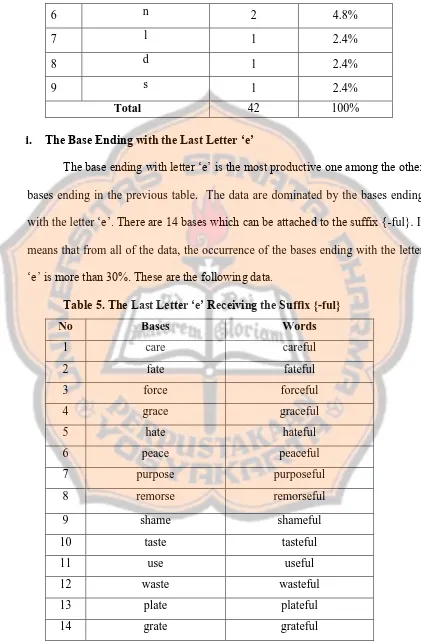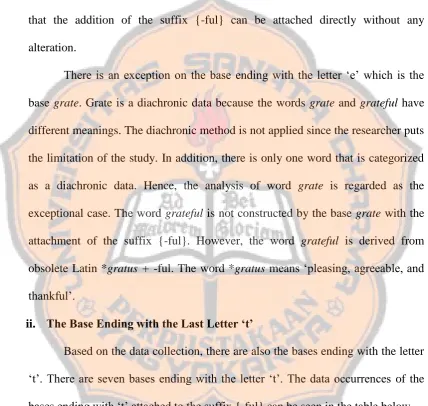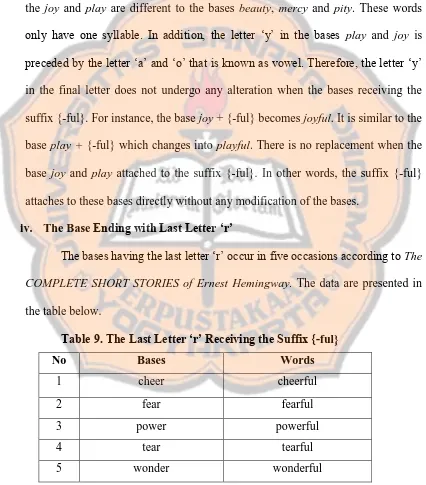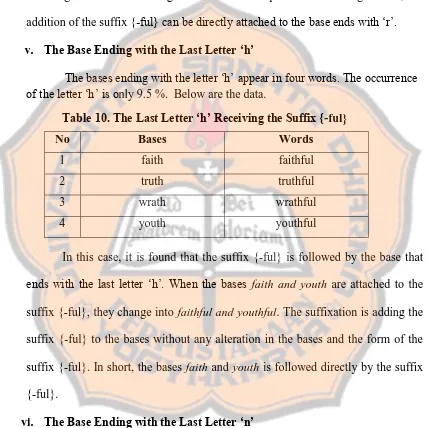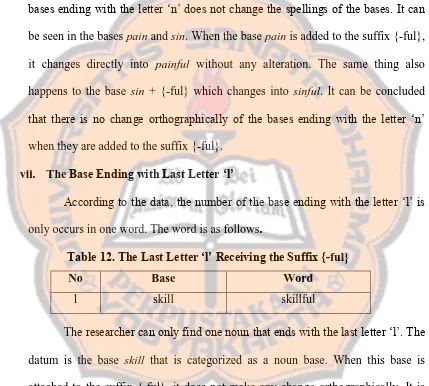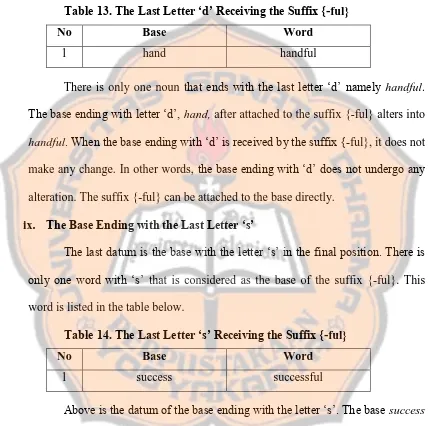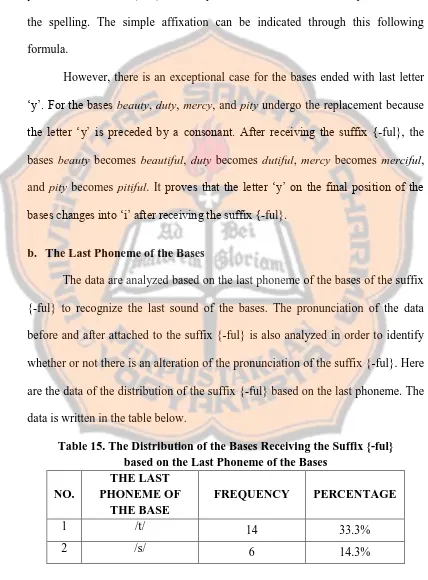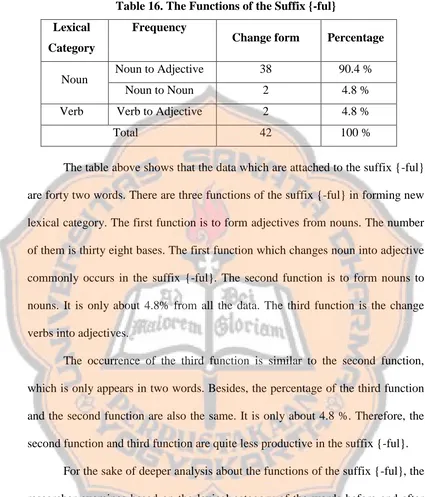xv ABSTRACT
FITRYANNISA, PRADINA. A Morphological Analysis of the Suffix {-ful} in Forming New Lexical Categories. Yogyakarta: English Letters Department, Faculty of Letters, Sanata Dharma University, 2017.
English language is known as a language that is productive in affixation. One kind of affixation is suffixation, which is the addition of suffix. Suffix is an important part of English since the process of suffixation is frequently used in this language. English has many suffixes with many different usages and functions. One of the suffixes in English is the suffix {-ful} that can be pronounced as either /f(ə)l/ or /fʊl/. Therefore, this study focuses on the suffix {ful}.
There are three problems formulated in this study. The first problem concerns with the words having the suffix {-ful}. The second problem concentrates on the functions of the suffix {-ful}. The last problem is to discover the morphophonemic processes that occur in the suffixation of the suffix {-ful}.
The data of the study are taken from The COMPLETE SHORT STORIES of Ernest Hemingway. Based on that source, there are 42 words ending with the suffix {-ful}. Oxford Advanced Learner’s Dictionary of Current English Ninth Edition (2015) is used a tool in order to find the phonetic form and lexical category. For the analysis, this study employs a morphological approach and phonological approach because both approaches can be used to answer the formulated problems.
As a result, the suffix {-ful} attaches to the noun bases and verb bases. The suffix {-ful} also attaches to the bases ending with the letters ‘e’, ‘t’, ‘y’, ‘r’, ‘l’, ‘d’, ‘s’ and phonemes /t/, /s/, /θ/, /i/, /n/, /ɪə/, eə/, /ʊə/, /ɔɪ/, /eɪ/, /ɪ/, /m/, /l/, /d/, /ə/, and /z/.
xvi ABSTRAK
FITRYANNISA, PRADINA. A Morphological Analysis of the Suffix {-ful} in Forming New Lexical Categories. Yogyakarta: Program Studi Sastra Inggris, Fakultas Sastra, Universitas Sanata Dharma, 2017.
Bahasa Inggris dikenal sebagai bahasa yang produktif dalam afiksasi. Salah satu jenis afiksasi adalah sufiksasi, yang merupakan sebuah proses menambahkan akhiran ke kata dasar. Akhiran adalah bagian penting dari bahasa Inggris karena proses sufiksasi sering digunakan dalam bahasa Inggris. Bahasa Inggris memiliki banyak akhiran kata dengan penggunaan dan fungsi yang berbeda-beda. Salah satu akhiran yang cukup produktif adalah akhiran {-ful} yang dapat dilafalkan /f(ə)l/ atau /fʊl/. Oleh sebab itu, studi ini hanya fokus pada akhiran {-ful}.
Dalam penelitian ini terdapat tiga rumusan masalah. Rumusan masalah pertama adalah persoalan mengenai kata kata yang menggunakan akhiran {-ful}. Pembahasan kedua fokus pada fungsi dari akhiran {-ful}. Pembahasan terakhir yaitu mengidentifikasi proses morfofonemik yang terjadi pada proses sufiksasi dari akhiran {-ful}.
Data-data untuk penelitian di ambil dari The COMPLETE SHORT STORIES of Ernest Hemingway. Berdasarkan sumber tersebut, ada 42 kata-kata yang berakhir dengan akhiran {-ful}. Oxford Advanced Learner’s Dictionary of Current English Ninth Edition (2015) digunakan sebagai alat bantu dengan tujuan untuk menemukan bentuk fonetik dan kategori kelas kata. Untuk tahap analisis, studi ini menggunakan pendekatan morfologi dan pendekatan fonologi karena dua pendekatan ini digunakan untuk menjawab rumusan masalah. Berdasarkan hasil analisis, kata dasar dari data yang berakhiran {-ful} merupakan kata benda dan kata kerja. Akhiran {-ful} juga melekat pada kata dasar yang berakhiran dengan huruf 'e', 't', 'y', 'r', 'l', 'd', 's' dan juga fonem /t/, /s/, /θ/, /i/, /n/, /ɪə/, eə/, /ʊə/, /ɔɪ/, /eɪ/, /ɪ/, /m/, /l/, /d/, /ə/, dan /z/.
ii
A MORPHOLOGICAL ANALYSIS OF THE SUFFIX {-FUL}
IN FORMING NEW LEXICAL CATEGORIES
AN UNDERGRADUATE THESIS
Presented as Partial Fulfillment of the Requirements for the Degree of Sarjana Sastra
in English Letters
By
PRADINA FITRYANNISA Student Number: 124214133
ENGLISH LETTERS STUDY PROGRAM DEPARTMENT OF ENGLISH LETTERS
FACULTY OF LETTERS SANATA DHARMA UNIVERSITY
v
STATEMENT OF ORIGINALITY
I certify that this undergraduate thesis contains no material which has been previously submitted for the award of any other degree at any university, and that, to the best of my knowledge, this undergraduate thesis contains no material previously written by any other person except where due reference is made in the text of the undergraduate thesis.
Yogyakarta, February 9, 2017
vi
LEMBAR PERNYATAAN PERSETUJUAN PUBLIKASI KARYA ILMIAH UNTUK KEPENTINGAN AKADEMIS
Yang bertanda tangan di bawah ini, saya mahasiswa Universitas Sanata Dharma Nama : Pradina Fitryannisa
Nomor Mahasiswa : 124214133
Demi pengembangan ilmu pengetahuan, saya memberikan kepada Perpustakaan Universitas Sanata Dharma karya ilmiah saya yang berjudul
A MORPHOLOGICAL ANALYSIS OF THE SUFFIX {-FUL} IN
FORMING NEW LEXICAL CATEGORIES
beserta perangkat yang diperlukan (bila ada). Dengan demikian saya memberikan kepada Perpustakaan Universitas Sanata Dharma hak untuk menyimpan, mengalihkan dalam bentuk media lain, mengelolanya dalam bentuk pangkalan data, mendistribusikan secara terbatas, dan memublikasikannya di internet atau media lain untuk kepentingan akademis tanpa perlu meminta izin kepada saya maupun memberikan royalti kepada saya selama tetap mencantumkan nama saya sebagai penulis.
Demikian pernyataan ini saya buat dengan sebenarnya.
Dibuat di Yogyakarta
Pada tanggal 9 Februari 2017
Yang menyatakan,
vii
viii
This undergraduate thesis
ix
ACKNOWLEDGEMENTS
Thanks and praises to Almighty God, Allah SWT, who gives me the health and strength so that I can finish my thesis. I would like to give big thanks for my mother, and my brothers. Thank you, mom, Hj. Kahfi Sabariah S.Pd., M.P.Fis. She is the only one who has been taking care of me until this day. I do not know how to thank you for all that you have done for me. For me, she is my personal hero.
I would give my special gratitude to my thesis advisor, Dr. Bernardine Ria Lestari, M.Sc., for the advice, guidance, and correction during the process I finish my undergraduate thesis. I would also like to thank my co-advisor, Anna Fitriati, S.Pd., M. Hum., for the suggestion and correction. I thank for the time and the knowledge given to me in order to finish my undergraduate thesis.
My friends also take a big role in writing my undergraduate thesis. Thanks for Julyan, Tjia, Sitoresmi, Amadah, Vitria, Desty, and Femi. They are always there for me for a long time. Besides, their support is really worth for me.
Then, my thanks are expressed to Adi and Katarina, who always accompany me any time. The last but not least, I would like to thank Aditya for the support and kindness that he gave me. Also, I would like to thank who support me from the beginning until this day.
x
CHAPTER IV: ANALYSIS RESULTS AND DISCUSSIONS ... 21
A. The Bases Receiving the Suffix {-ful} ... 22
1. Lexical Category of the Base ... 22
a. The Noun Bases ... 24
xi
2. The Distribution of the Bases receiving the Suffix {-ful} ... 26
a. The Last Letters of the Base ... 26
Appendix 2: Data Collection of the Verb Bases ... 60
Appendix 3: The Words with Bases Ending with the Letter ‘e’ ... 60
xii
Appendix 12: Morphophonemic Processes of the Suffix {-ful} ... 62
xiii
LIST OF TABLES
Table 1. The Bases of the Suffix {-ful} ... 23
Table 2. The Noun Bases Receiving the Suffix {-ful} ... 24
Table 3. The Verb Bases Receiving the Suffix {-ful} ... 25
Table 4. The Occurrence of the Last Letters ... 26
Table 5. The Last Letter ‘e’ Receiving the Suffix {-ful} ... 27
Table 6. The Last Letter ‘t’ Receiving the Suffix {-ful} ... 28
Table 7. The Last Letter ‘y’ Receiving the Suffix {-ful} ... 29
Table 8. The Last Letter ‘y’ Receiving the Suffix {-ful} ... 30
Table 9. The Last Letter ’r’ Receiving the Suffix {-ful} ... 31
Table 10. The Last Letter ‘h’ Receiving the Suffix {-ful} ... 32
Table 11. The Last Letter ‘n’ Receiving the Suffix {-ful} ... 33
Table 12. The Last Letter ‘l’ Receiving the Suffix {-ful} ... 33
Table 13. The Last Letter ‘d’ Receiving the Suffix {-ful} ... 34
Table 14. The Last Letter ‘s’ Receiving the Suffix {-ful} ... 34
Table 15. The Distribution of the Bases Receiving the Suffix {-ful} based on the Last Phoneme ... 35
Table 16. The Functions of the Suffix {-ful} ... 44
Table 17. Vowel Change ... 50
Table 18. Vowel Change from /i/ into /ɪ/ ... 51
Table 19. Vowel Change from /ɑ/ into /æ/... 52
xiv ABSTRACT
FITRYANNISA, PRADINA. A Morphological Analysis of the Suffix {-ful} in Forming New Lexical Categories. Yogyakarta: English Letters Department, Faculty of Letters, Sanata Dharma University, 2017.
English language is known as a language that is productive in affixation. One kind of affixation is suffixation, which is the addition of suffix. Suffix is an important part of English since the process of suffixation is frequently used in this language. English has many suffixes with many different usages and functions. One of the suffixes in English is the suffix {-ful} that can be pronounced as either /f(ə)l/ or /fʊl/. Therefore, this study focuses on the suffix {ful}.
There are three problems formulated in this study. The first problem concerns with the words having the suffix {-ful}. The second problem concentrates on the functions of the suffix {-ful}. The last problem is to discover the morphophonemic processes that occur in the suffixation of the suffix {-ful}.
The data of the study are taken from The COMPLETE SHORT STORIES of Ernest Hemingway. Based on that source, there are 42 words ending with the suffix {-ful}. Oxford Advanced Learner’s Dictionary of Current English Ninth Edition (2015) is used a tool in order to find the phonetic form and lexical category. For the analysis, this study employs a morphological approach and phonological approach because both approaches can be used to answer the formulated problems.
As a result, the suffix {-ful} attaches to the noun bases and verb bases. The suffix {-ful} also attaches to the bases ending with the letters ‘e’, ‘t’, ‘y’, ‘r’, ‘l’, ‘d’, ‘s’ and phonemes /t/, /s/, /θ/, /i/, /n/, /ɪə/, eə/, /ʊə/, /ɔɪ/, /eɪ/, /ɪ/, /m/, /l/, /d/, /ə/, and /z/.
xv ABSTRAK
FITRYANNISA, PRADINA. A Morphological Analysis of the Suffix {-ful} in Forming New Lexical Categories. Yogyakarta: Program Studi Sastra Inggris, Fakultas Sastra, Universitas Sanata Dharma, 2017.
Bahasa Inggris dikenal sebagai bahasa yang produktif dalam afiksasi. Salah satu jenis afiksasi adalah sufiksasi, yang merupakan sebuah proses menambahkan akhiran ke kata dasar. Akhiran adalah bagian penting dari bahasa Inggris karena proses sufiksasi sering digunakan dalam bahasa Inggris. Bahasa Inggris memiliki banyak akhiran kata dengan penggunaan dan fungsi yang berbeda-beda. Salah satu akhiran yang cukup produktif adalah akhiran {-ful} yang dapat dilafalkan /f(ə)l/ atau /fʊl/. Oleh sebab itu, studi ini hanya fokus pada akhiran {-ful}.
Dalam penelitian ini terdapat tiga rumusan masalah. Rumusan masalah pertama adalah persoalan mengenai kata kata yang menggunakan akhiran {-ful}. Pembahasan kedua fokus pada fungsi dari akhiran {-ful}. Pembahasan terakhir yaitu mengidentifikasi proses morfofonemik yang terjadi pada proses sufiksasi dari akhiran {-ful}.
Data-data untuk penelitian di ambil dari The COMPLETE SHORT STORIES of Ernest Hemingway. Berdasarkan sumber tersebut, ada 42 kata-kata yang berakhir dengan akhiran {-ful}. Oxford Advanced Learner’s Dictionary of Current English Ninth Edition (2015) digunakan sebagai alat bantu dengan tujuan untuk menemukan bentuk fonetik dan kategori kelas kata. Untuk tahap analisis, studi ini menggunakan pendekatan morfologi dan pendekatan fonologi karena dua pendekatan ini digunakan untuk menjawab rumusan masalah. Berdasarkan hasil analisis, kata dasar dari data yang berakhiran {-ful} merupakan kata benda dan kata kerja. Akhiran {-ful} juga melekat pada kata dasar yang berakhiran dengan huruf 'e', 't', 'y', 'r', 'l', 'd', 's' dan juga fonem /t/, /s/, /θ/, /i/, /n/, /ɪə/, eə/, /ʊə/, /ɔɪ/, /eɪ/, /ɪ/, /m/, /l/, /d/, /ə/, dan /z/.
1 CHAPTER I
INTRODUCTION
A. Background of the Study
Language as a device of communication has an important role in people’s
lives. People always need to communicate with others in order to share their
attitudes, expressions, ideas, and feelings. Basically, people must not only
understand their own language but also learn other languages from other countries
so that they can communicate with each other fluently and easily. Therefore,
language and people cannot be separated.
The systematic study of language itself is called linguistics. Morphology is
one of linguistics that is concerned with words and word formation. Katamba
states that morphology is “the study of the formation of words and internal
organization of word” (1993: 30). In other words, morphology is the study dealing
with the word formation. The word formation is related to how new words are
formed and how the words are created.
Affixation is a part of word formation. It means, affixation is one of the
types of word formations. Affixation is the most frequent process to form words
(Bauer, 1988: 19). Another theory taken from Katamba states that bases as “any
unit whatsoever to which affixes of any kind can be added. In other words, all
roots are bases” (1993: 45). It indicates the existence of bases before added by any
suffixes or prefixes. An affix is divided into three types, namely prefix, infix, and
placed in the middle of two bases. Lastly, suffix is an affix attached to the end of
base.
The main focus of this study is the form of the affixation. To limit the
scope of the study, the adjective suffix {-ful} is discussed in this study. The
researcher has the attempts to analyze deeper and explain more specific about this
suffix. The consideration of choosing this topic is because the suffixation is the
most productive process in English vocabularies. Moreover, the suffixation has
existed since the period of Old English. One of suffixes from Old English that still
exists in Modern English is the suffix {-ful}. Carol mentions that the English the
suffix {-ful} in masterful, playful and useful creates adjectives. Meanwhile the
words such as armful, cupful, and spoonful create nouns. The suffix {-ful} is
developed from the adjective -full, which has already existed in Old English.
However, the suffix {-ful} already used in present-day English (2014: 272-273).
In other word, the suffix {-ful} is originated from Old English “full” which means
“full-of”. The usage of “full” is commonly attached at the head of a word such as
fulbrecan means “full of violate”. In addition, the suffix {-ful} is often used in
English words and it is easy to find in daily life. The English suffix {-ful} in
beautiful and shameful creates an adjective, while the suffix {-ful} in cupful and
spoonful creates a noun. From the changes above, the researcher finds that the
suffix {-ful} forms the lexical categories of words differently.
In a morpheme, there are two morphological processes. The first one is
derivational morpheme and the second one is inflectional morpheme. O’Grady,
morpheme that can create a word with a meaning or category distinct from the
stem of word or stem” (2010: 122). The function of suffix {-ful} is categorized
into the derivational suffix that makes a new word with a new meaning, and thus
it also changes the lexical category.
Suffix is an important part of the English language since the process of
affixation is often used to form a new word. There are several suffixes which
change the lexical category and the meaning of the words. For instance, the word
beauty (noun) and nation (noun) after added to the suffixes {-ful} and {-al}
become beautiful (adjective) and national (adjective). It shows that these suffixes
change the lexical category of the words before and after attached to the suffixes.
Thus, the researcher attempts to prove that the suffix {-ful} changes the lexical
category through the morphological process. In addition, each suffix has its own
rules of usage, and it is used with different words because not all the words can be
attached to the suffix {-ful}.
In order to gain the adequate data for this study, the researcher analyzes
twenty five short stories from The COMPLETE SHORT STORIES of Ernest
Hemingway. The reasons why the researcher uses that short stories are because
that short story is often used by the students of English Letters Department of
Sanata Dharma University, especially in several courses, such as Prose 1, Writing
VI (Essay Writing), and Writing V (Creative Writing). Besides, in this short story,
there are many words containig the suffix {-ful}. Therefore, this study aims to
look for any words containing the suffix {-ful} from The COMPLETE SHORT
This study is expected to give the readers better understanding in learning
adjective suffixes, especially in learning the suffix {-ful}. It is helpful for the
readers to understand the form and the function of the suffix {-ful}. Moreover,
through this study, the readers are given more understanding about the
morphophonemic processes of the suffix {-ful}.
B. Problem Formulation
This study aims to answer three formulated problems which are:
1. What are the bases receiving the suffix {-ful} inside the short stories?
2. What are the functions of the suffix {-ful}?
3. How do the morphophonemic processes occur in the suffix {-ful}?
C. Objectives of the Study
Based on the problem formulation, there are some objectives to be
achieved in this study. The twenty-five short stories are analyzed by the researcher
in order to find out the words having the suffix {-ful}. Besides, the aim of the first
objective is to discover the distributions of the suffix {-ful} when attaching to the
bases.
The second objective of this study is to identify what the functions of the
suffix {-ful} are. The researcher also examines the characteristics of bases
receiving the suffix {-ful}. The third objective of this study is to identify what the
morphophonemic processes help the researcher analyzes the alteration that occurs
when the suffix {-ful} attaches to the bases.
D. Definition of Terms
In this part, the researcher provides the definition of terms used in this
study. The terms are going to be discussed are suffix, morphophonemic process,
and lexical category.
The first terminology is suffix. Suffix as suggested by Matthews is an affix
that comes after the form to which it is added (1997: 362). In sort, suffix is a
process of adding a morpheme to the end of base or stem in order to form a new
word. There are many suffixes used in English, some of them are the suffix {-ful}
and the suffix {-al}. The examples of words attached by suffix {-ful} are
beautiful, cheerful, useful, and peaceful. The examples of words attached to the
suffix {-al} are national, natural, and regional.
The second terminology is a morphophonemic process. A
morphophonemic process as explained by Crystal is
a branch of linguistic referring to the analysis and classification of the PHONOLOGICAL, factors with affect the appearance of morphemes, or, correspondingly, the GRAMMATICAL factors which affect the appearance of phonemes (2008:341).
The last terminology is lexical category. Lexical category is the
grammatical category or syntactic class (noun, verb, adjective, and adverb) a word
belongs to (Fromkin and Rodman, 1988: 123). In this study, one of the functions
of the suffix {-ful} changes the lexical category which is a noun to adjective class.
of lexical category. It is changed into an adjective class. Another example is the
word achieve. The base achieve as a verb changes into achievement as a noun
7 CHAPTER II
REVIEW OF LITERATURE
A. Review of Related Studies
In this part, the researcher intends to review five studies that can be related
to this study. Those five studies have certain similarities to this study. Firstly, the
studies reviewed are related to the same topic as this study which is suffixation.
Secondly, the studies reviewed have the same methodology as this study which is
a morphological study. Thirdly, the studies reviewed have the same aim as this
study which is to find the meaning of the suffix in certain words.
The first related study is taken from Prasetya’s thesis (2012). In his study,
he figures out two things. The first is the characteristics of base followed by the
suffix {-age} and the suffix {-ment}. The second thing is the functions of the
suffixes {-age} and {-ment}. The previous researcher examines which word
should be added to the suffix {-age} and which word should be added to the suffix
{-ment}.
After analyzing his study, Prasetya recognizes that there are some results
of his study. Firstly, Prasetya finds out that the only base that can be attached to
the suffix {-ment} is a verb. Secondly, the suffix {-age} can be attached to certain
adverbs, nouns, and verbs. Specifically, the noun base for this suffix can be both
concrete noun and abstract noun. As reading his study, there are differences and
similarities between Prasetya’s study and this study. From the characteristics of
{-ful} follow either a concrete noun or an abstract noun. It is also similar to the
suffix {-age} that can follow either a concrete noun or an abstract noun.
The difference from the study that is conducted by Prasetya and this study
are the functions of the suffixes. The previous researcher identifies that the
functions of suffix {-age} change a verb to a noun, a noun to a noun, and adverb
to a noun, whereas the suffix {-ment} only has one function that changes a verb to
a noun. Compared to this study, the researcher only focuses on the functions of
the suffix {-ful}.
The second related study is taken from Maharani’s undergraduate thesis
(2000). This study discusses the bases receiving the suffix {-cy} and the
allomorphs of the suffix {-cy}. As a result, the suffix {-cy} is a derivational suffix
that mostly attaches to adjective bases although it also attaches to noun and verb
bases. It can be concluded that this study analyzes the bases receiving the suffix
{-cy}. In addition, this study argues that the suffix {-cy} represents two allomorphs
namely {-ancy} and {-ency}.
This study is closely related to the previous study. In the beginning, the
present study starts with the distribution of suffix {-ful}, which is related to the
analysis of the base. This study also examines the base that can be combined by
the suffix {-ful}. Furthermore, from the analysis of the bases, there is a similarity
shared by both studies which lies on the objective. Both studies aim to find out the
bases that mostly attach to the suffixes {-ful} and {-cy}.
The third related study is from Setyorini’s undergraduate thesis (2005).
{-al} by using some theories, such as theories of morpheme and morphophonemic
processes. The data in this study are taken from Corpus Morphology and
Webster’s Encyclopedic Dictionary of the English Language. After conducting
this study, Setyorini finds out that the suffix {-al} forms a noun to an adjective
class. In other words, the suffix {-al} attaches to the noun bases.
She also identifies the morphophonemic processes that occur in the suffix
{-al}. In the morphophonemic processes, she discovers there are two phonological
changes. The first change is a stress shift and the second is a consonant change.
For instance, the process of stress shift is shown in the word 'government + {-al} which becomes govern'mental. The primary stress is moved to the penultimate
syllable when the word 'government attached to the suffix {-al}.
The focus of the present study is rather different from Setyorini’s. This
present study focuses on the suffix {-ful} since the function of suffix {-ful} is to
form an adjective. Whereas, the previous study only focuses on the suffix {-al} as
an adjective suffix. The suffix {-ful} is not discussed in the previous study even
though the suffix {-ful} belongs to the adjective suffix.
Moreover, this present study is different from the previous study since the
subjects of each study are different. The previous researcher uses Corpus
Morphology and Webster’s Encyclopedic Dictionary of the English Language as
the object of her study. On the other hand, the present researcher takes some data
from The COMPLETE SHORT STORIES of Ernest Hemingway as the object of
Other than differences, Setyorini’s study is supportive to the present study
because of the similarity. The similarity lies on how the distribution of the suffix
{-al} occurs. Besides, the discussions of morphophonemic processes are also
elaborated in these two studies. In the present study, the morphophonemic
processes are analyzed in the next chapter.
Another related study is from Hananto’s thesis (2015). This study argues
that the suffix {-ive} is a derivational suffix having the function to create an
adjectival word. Based on the lexical category, the bases of the suffix {-ive} are
verbs and nouns. However, most of the bases are verbs.
After examining Hananto’s study, there is a similarity and difference
found among these two studies. From the explanation above, based on their
function, the suffixes {-ful} and {-ive} form the adjectival words. In addition to
that, the suffixes {-ful} and {-ive} are categorized as adjectival suffixes. Although
they have the same function in order to create adjectival words, they are different
in the acceptance of the bases. The suffix {-ful} is mostly from a noun bases while
the suffix {-ive} is mostly from a verb bases.
The improvement of all the studies can be seen through the researcher’s
findings in this study. All of the studies above have not analyzed the adjectival
suffix. Therefore, by discovering the meaning and function of the adjectival
suffix, this study aims to improve all of the studies above. In order to develop this
study, the researcher uses some related studies which more or less have
B. Review of Related Theories
1. Morphology
O’Grady, Dobrovolksky, and Aronoff defines morphology as “the system
of categories and rules involved in word formation and interpretation” (1989: 4).
Another theory is from Bauer, morphology is “the study of words and their
structure” (2003: 3).
As understanding those theories, the researcher concludes that morphology
is a sub-branch of linguistics that deals with the internal structure of words. In
short, morphology relates to the word formation. By applying theories of
morphology in this study, the researcher is able to recognize how to identify
morphemes and their distribution in forming words. Therefore, morphology is
used to strengthen the object of this study.
a. Morpheme
O’Grady and John Archibald define a morpheme is a smallest language
element that contains information about meaning or function (2010: 116-117).
Another theory is taken from Kreidler, he state that morpheme are the minimal
units of language (1989: 13). For instance, the words big, run, green, unhappy,
quickness, and sadness are morphemes. Some words such as big, run, and green
only contain one morpheme while the words such as unhappy, quickness, and
sadness are the words contain more than one morpheme.
Akmajian et al. (2001: 18) state that “morphemes are futher categorized
into two classes: free morpheme and bound morphemes. A free morpheme can
morpheme can stand alone as an independent word. Meanwhile, a bound
morpheme is a morpheme which cannot stand alone. It must be attached to
another morpheme in forming a word.
On the other hand, a bound morpheme is a morpheme that must be
attached to another element. Based on the definition, it can be referred that a
bound morpheme cannot stand independently. It must be followed by a free
morpheme.
b. Derivational Morpheme
In explaining about the derivational morpheme, O’Grady et al. state that
derivational morpheme is a bound morpheme that creates a new word with a new
meaning (2010: 122). In other words, when a morpheme is attached to a base, it
changes the meaning and the lexical category of the new word. For instance, the
base workwhich is a verb. It is changed into adjective when the base receiving the
suffix {-er} so that it becomes the word worker.
c. Affixation
According to Dwijatmoko (2003: 9) affixation is “the addition of an affix
(prefix, infix, and suffix) to a base to form a new word”. He mentions that there
are three types of affixes that are prefix, infix, and suffix. It short, the affixes can
be divided into some types depending on the position of an affix attached to the
base.
i. Suffix
According to O’Grady and Guzman, a suffix is “an affix that is attached to
O’Grady and Archibald (2010: 120), an affix that is placed in the last position of
the base is called as a suffix. In short, suffix is a morpheme added to the end of
the base to create a new word. Some examples of suffixes in English are -nessin
‘happiness’, -ize in ‘winterize’, and -al in ‘national’. Therefore, the theory of
suffix is needed to be discussed since the object of this study is the suffix {-ful}.
ii. Infix
O’Grady and Archibald (2010: 120) state that an infix is one type of
affixes which is placed in the middle of a base. Another theory is taken from
Crystal. He defines that “infix is a term used in morphology referring to an affix
which is added within a root or stem” (2008: 243).
iii. Prefix
According to O’Grady and Guzman (1989: 138), a prefix means an affix
which is attached before a base word. In short, a prefix is an affix added to the
front or beginning of the root word to change the meaning. An instance is in the
word un-important. The prefix –un modifies the meaning of unimportant into
negative meanings. The other examples of the prefix are the words impossible,
release, and irregular.
2. Noun Categories
According to Hurford, abstract nouns are
From this theory, an abstract noun is classified as an idea, a concept, an
emotion, and a quality. The researcher finds out that an abstract noun is something
that cannot be physically touched. Abstract nouns cannot be experienced directly
with the senses. Therefore, the five physical senses cannot determine some
abstract nouns. Meanwhile, concrete nouns can be identified through five senses
such as taste, touch, sight, hearing, and smell.
3. Phonology
Phonology is defined as the description of the speech sound of a language
and the systematic of phonetic transcription variation found in language is known
as phonology (Kreidler, 1989: 13). Shortly, phonology is the study of sound
patterns. Phonology refers to the representation of the sound patterns in a
language or human’s sounds. It discusses how speech sounds are produced.
The morphophonemic process is a combination of morphology and
phonology. The morphophonemic process deals with the pronunciation change of
morpheme. in short, the morphophonemic process is a process of form changes in
which phoneme and morpheme are involved. In English, there are some
morphophonemic changes, namely assimilation, consonant change, vowel change,
deletion, dissimilation, and stress shift (Wardhaugh, 1977: 198). One of the
morphophonemic processes is insertion. The first type is segment insertion and
segment deletion. Segment insertion is the process of inserting a consonant or a
vowel. It is also called epenthesis (Fromkin, Rodman, and Hyams, 2011: 312). On
Fromkin et al., (2011: 313) also state that there is also an insertion of
schwa that is called as epenthetic schwa /ə/. For instance, the word nature
undergoes the segment insertion. The word nature (noun) /'neɪt∫ə(r)/ becomes
natural (adjective) /'næ∫rəl/. After attaching {-al} to the noun, there is an
insertion of /r/ when it is inserted before the suffix {–al} /-əl/. Basically, the word
“nature” has an optional consonant /r/ in the final sound (often omitted).
The second type is vowel change. A vowel change is a change of vowel
after a base is attached to an affix (Wardhaugh, 1977: 198-200). In short, vowel
change is the process of changing vowel into another vowel. For example, the
word man undergoes the vowel change in the plural form. The vowel change is
from the vowel /ae/ in the word maninto /e/ in the plural word men.
C. Theoretical Framework
In this study, there are several linguistic theories that are used for the data
analysis. In order to analyze the study, the theory of morphology is used as the
primary theory. Morphology is related to the word formation which involves the
suffix. From the morphological theory, we can know the process how the word is
formed including affixation, the change of word class, and the change of meaning.
By using morphology as one of the theories, the researcher finds out that the
suffix {-ful} creates a new word and changes the lexical category.
This study consists of three formulated problem. The first formulated
problem is to identify the bases receiving the suffix {-ful}. Besides, the
theory of affixation is necessarily needed in order to identify the process of adding
the suffix {-ful} to base words.
The second formulated problem discusses the function of the suffix {-ful}.
Moreover, the noun categories are useful to dig out the characteristics of the bases
receiving the suffix {-ful}. In answering the second formulated problem, the
researcher applies the theories of noun categories and derivational morphemes.
Those theories are used to find out that the suffix {-ful} has its own function. In
this study, the suffix {-ful} is classified as a derivational morpheme. Additionally,
when a derivational morpheme is attached to a base, there is a change of functions
and meanings before and after the base is added to the suffix {-ful}.
The third problem formulation is to analyze the morphophonemic
processes that occur. In answering the third problem formulated, the researcher
applied the theory of morphophonemic processes. The theory of morphophonemic
process is to show how certain morphophonemic processes occur and what the
17 CHAPTER III
METHODOLOGY
A. Object of the Study
The object of this study is the words having the suffix {-ful}. This object
is the words ended with the suffix {-ful} taken from The COMPLETE SHORT
STORIES of Ernest Hemingway. The twenty five short stories are chosen as the
primary data source because there are many words containing the suffix {-ful}. It
is also used as the reference by university students who are taking several courses,
such as Prose I and Writing VI (Essay Writing).
Besides, Oxford Advanced Learner’s Dictionary of Current English Ninth
Edition (2015) is used as an open-source tool to check the International Phonetic
Alphabet (IPA). The consideration for choosing this dictionary is because it
provides over 185.000 words, the phonetic transcription, lexical category of each
word, and comprehensive meanings. Furthermore, this dictionary is a reliable
dictionary since it is usually used as the reference for the academic study.
B. Approach of the Study
The researcher uses morphology and phonology as the approaches in
analyzing the words ended with the suffix {-ful}. The researcher uses those
approaches because they are related to each other. The first is the morphological
approach, which is used in analyzing the words having the suffix {-ful}. Kreidler
analyzing the word structure including morphemes (1989: 13). Crystal states that
“morphological process is a process of the words formation” (2008: 58). In this
study, the morphological approach shows that morphology relates to suffix in
involving the word formation. Therefore, the morphological approach is
appropriate for this study because the researcher is about to know how to form the
words. It can be said that the morphological approach is used to examine the
form-changing of the word attaching the suffix {-ful}.
The second is the phonological approach. It is also used to complete the
study. Kreidler defines that phonology deals with the knowledge of the sound
pattern of a language (1989: 10). As understanding the theory, it is concluded that
phonology is a study of the sound patterns. It also concerns with the way speech
sounds are organized into sound systems by describing pronunciations. In other
words, it is used to know what is relevant in pronunciation, what makes it possible
to communicate, and what makes utterance different from others.
C. Method of the Study
The method of study is divided into two subparts. The first is data
collection. The second is data analysis.
1. Data Collection
The data are collected from The COMPLETE SHORT STORIES of Ernest
Hemingway. The researcher chooses twenty five short stories to be analyzed in
this study. The researcher gains the data further by taking the words having the
word not having the suffix {-ful} are not included to the data collection. The data
collection uses sampling method. It means that in getting the sample data, the
researcher only collects all the words receiving the suffix {-ful} from The
COMPLETE SHORT STORIES of Ernest Hemingway.
Based on the source, there are forty two words in which the suffix {-ful}
attaches to those words. Meanwhile, Oxford Advanced Learner’s Dictionary of
Current English Ninth Edition (2015) is used as a tool to answer the formulated
problems. The Oxford dictionary is needed because it provides the International
Phonetic Alphabet (IPA) to find the phonetic transcription. By using this
dictionary, the researcher analyzes the phonological changes and lexical
categories of each word. In this study, the data collection uses the sampling
method because the researcher only collects the words having the suffix {-ful}.
2. Data Analysis
In analyzing the data, the researcher does some following steps in order to
answer the problems formulation. Firstly, the researcher only collects the data
from twenty five short stories in The COMPLETE SHORT STORIES of Ernest
Hemingway. The data collection is the words having the suffix {-ful}. To reduce
errors in analyzing the base, the researcher uses the Oxford Advanced Learner’s
Dictionary of Current English Ninth Edition (2015) as a tool to figure out the
bases of analyzed words having the suffix {-ful}. The Oxford dictionary also
helps the researcher to check the IPA of the bases and the words receiving the
suffix {-ful}. Those bases are categorized based on their lexical categories, last
The second formulated problem analyzes the function of the suffix {-ful}.
The first step is to identify the words having the suffix {-ful}. The next step is to
make a classification of each base based on the lexical category. By doing this
classification, the researcher discovers the change of lexical category before and
after the suffix {-ful} is attached to the bases. From this classification, the
researcher is able to determine the functions of the suffix {-ful} and the
characteristics of the bases receiving the suffix {-ful}.
Lastly, the International Phonetic Alphabet (IPA) is applied to answer the
third formulated problem. At this step, the researcher decides to use the Oxford
Advanced Learner’s Dictionary of Current English Ninth Edition (2015) because
this dictionary provides the standard IPA. The researcher uses the IPA to know
the phonetic transcription and the pronunciation of each word. It is helpful for the
analysis of morphophonemic processes to know what pattern which occurs. There
are two classification analyzed. The first one is the IPA of the words having the
suffix {-ful}. The second one is the IPA of its bases. The categorization aims to
show the morphophonemic processes in the suffixation of the suffix {-ful} by
21 CHAPTER IV
ANALYSIS RESULTS AND DISCUSSIONS
In this chapter, three formulated problems are discussed. Chapter IV contains the analysis and the results of the three formulated problems. The first formulated problem is the bases to which suffix {-ful} can be attached to, the second is the functions of the suffix {-ful}, and the third is how the morphophonemic processes of the suffix {-ful} occur. After collecting the data, the researcher concludes that the suffix {-ful} makes a new word with a new meaning. The suffix {-ful} is used to change a word from one grammatical class to another. In other words, the suffix {-ful} usually changes the lexical category. Therefore, the suffix {-ful} is characterized as a derivational suffix.
In answering the first formulated problem, the researcher uses The COMPLETE SHORT STORIES of Ernest Hemingway and Oxford Advanced Learner’s Dictionary of Current English Ninth Edition (2015). However, the
researcher chooses The COMPLETE SHORT STORIES of Ernest Hemingway as the main source to collect the words.
suffix {-ful}. However, in the result of data, there are some bases that have more than one lexical category. Concerning those data, the researcher can identify the function of the suffix {-ful} by seeing the lexical category of each base and its alteration after the suffix {-ful} is added. In answering the third formulated problem, the researcher applies International Phonetics Alphabet symbol in order to examine the base of the suffix {-ful}.
A. The Bases Receiving the Suffix {-ful} 1. Lexical Category of the Base
From the whole content of the short stories, the researcher discovers that there are two hundred and sixty nine words ending with the suffix {-ful}. However, after the calculation process, the researcher actually finds out only forty two words receiving the suffix {-ful} because the others words are only repeat words of the words already exist. All those forty two words are the primary data of this research.
All the bases in this study are categorized as a free morpheme because they can stand on their own. Thus, all bases receiving the suffix {-ful} are considered as a free morpheme. The suffix {-ful} should attaches to a free morpheme because the suffix {-ful} cannot stand alone. Cartair-McCarthy (2002:
137) states that “-ful most always attaches to free bases”.
adjective, adverb, noun, and verb. As stated by Cartair-McCarthy (2002: 45) “the
terms for lexical categories are „adjective‟, „noun‟, and „verb‟.
Traditionally, the term of word class is derived from a traditional terminology which is part of speech. Many contemporary linguists also define word classes as lexical categories. Every base in the data do not have the same lexical categories. They have their own lexical categories or part of speech. Plag (2003: 90) asserts that the suffix {-ful} is typically attached to the noun base. The examples of the data are revealed as follows.
Table 1. The Bases of the Suffix {-ful}
No Bases Words
1 care careful
2 cheer cheerful
3 resent resentful
4 taste tasteful
5 use useful
6 waste wasteful
of those bases is a noun word so that those words considered as a noun when they are attached to the suffix {-ful}.
Other examples are the words beauty and fright. The base beauty after receiving the suffix {-ful} becomes beautiful which is known as an adjective. It is similar to the base beauty, the base fright is changed from a noun to an adjective. For the words beauty and fright, they are classified only as noun bases. In short, these words only have one lexical category.
Other examples are the adjective words resentful and forgetful. Those two bases come from the verb bases resent and forget. The bases resent and forget dominated by noun bases. There are forty noun bases receiving the suffix {-ful}. In this analysis, the researcher only puts down some examples. Below are some examples.
7 mercy merciful Therefore, the suffix {-ful} takes the noun as its base.
b. The Verb Bases
After analyzing the data, verb bases can be attached to the suffix {-ful}. Below are the data examples of the verb bases taken from The COMPLETE SHORT STORIES of Ernest Hemingway and also reinforced with Oxford Advanced Learner’s Dictionary of Current English Seventh Edition (2005).
Table 3. The Verb Base Receiving the Suffix {-ful}
No Bases Words
1 resent resentful
2 forget forgetful
receiving the suffix {-ful}. The base resent is classified as a verb base. After the base resent attaches to the suffix {-ful}, it becomes an adjective word resentful. It is also similar to the base forget. It takes a verb as its base.
2. The Distribution of the Bases Receiving the Suffix {-ful}
There are two methods which are applied in analyzing the bases receiving the suffix {-ful}. The first method is the analysis of the last letters. The data are examined based on the last letter of the bases of the suffix {-ful}. In the second method, the data are examined based on the last phoneme of the bases receiving the suffix {-ful}.
a. The Last Letters of the Base
6 n 2 4.8%
7 l 1 2.4%
8 d 1 2.4%
9 s 1 2.4%
Total 42 100%
i. The Base Ending with the Last Letter ‘e’
The base ending with letter „e‟ is the most productive one among the other
bases ending in the previous table. The data are dominated by the bases ending with the letter „e‟. There are 14 bases which can be attached to the suffix {-ful}. It means that from all of the data, the occurrence of the bases ending with the letter
„e‟ is more than 30%. These are the following data.
The table above shows the bases ending with the letter „e‟. After the suffixation of the suffix {-ful}, the words such as, fateful, tasteful, useful, and wasteful are formed. The suffix {-ful} does not change to any other form in the words tasteful, useful, wasteful, and fateful. From this analysis, we can discover that the addition of the suffix {-ful} can be attached directly without any alteration.
There is an exception on the base ending with the letter „e‟ which is the
base grate. Grate is a diachronic data because the words grate and grateful have different meanings. The diachronic method is not applied since the researcher puts the limitation of the study. In addition, there is only one word that is categorized as a diachronic data. Hence, the analysis of word grate is regarded as the exceptional case. The word grateful is not constructed by the base grate with the attachment of the suffix {-ful}. However, the word grateful is derived from obsolete Latin *gratus + -ful. The word *gratus means „pleasing, agreeable, and
thankful‟.
ii. The Base Ending with the Last Letter ‘t’
Based on the data collection, there are also the bases ending with the letter
„t‟. There are seven bases ending with the letter „t‟. The data occurrences of the
bases ending with „t‟ attached to the suffix {-ful} can be seen in the table below.
Table 6. The Last Letter ‘t’ Receiving the Suffix {-ful}
No Bases Words
1 doubt doubtful
2 forget forgetful
4 hurt hurtful
5 resent resentful
6 respect respectful
7 tact tactful
8 thought thoughtful
The suffix {-ful} also attaches to the bases ending with the letter „t‟. There
are eight bases ending with „t‟ that are attached to the suffix {-ful}. The existence
of the bases ending with the letter „t‟ is more than 20%. It means that the bases
ending with the letter „t‟ become the second productive among other letters.
From the table above, the researcher finds out that almost the entire bases ending with „t‟ have no modification. For instance, the base doubt + {-ful} becomes doubtful. Other examples are the bases fright and hurt + {-ful} change into frightful and hurtful. Another base is the base thought + {-ful} becomes thoughtful. It can be concluded that the bases ending with „t‟ do not undergo the alteration. In other words, the attachment of the suffix {-ful} is involved directly without causing any changes.
iii. The Base Ending with Last Letter ‘y’
The suffix {-ful} also attaches to the bases ending with the letter „y‟. The bases ending with the letter „y‟ occurs in six words. The words are presented in the following list below.
Table 7. The Last Letter ‘y’ Receiving the Suffix {-ful}
No Bases Words
1 beauty beautiful
3 mercy merciful
4 pity pitiful
When the suffix {-ful} attaches to the bases such as beauty, duty, mercy, and pity, there is a replacement of the letter „y.‟ The last letter „y‟ of the base is
omitted and replaced with the letter „i‟ when the suffix {-ful} attaches to the
bases. For instance, the base beauty which becomes beautiful with „y‟ is omitted
and converted into „i‟.
The bases duty and mercy are similar to the base beauty. The base duty becomes dutiful, and the base mercy becomes merciful. The letter „y‟ in the final position of the base is omitted. The researcher figures out that these bases have two consonant letters in the final position. The consonant „y‟ appears in the final
position after the existence of the consonants „t‟ and „c‟. It can be concluded that
the consonant „y‟ is omitted when it is followed by consonants „t‟ and „c‟ in the
bases beauty, duty, and mercy when receiving the suffix {-ful}. In addition, the bases beauty, duty, mercy, and pity have two syllables. The letter „y‟ that is placed in the second syllable as the final letter will change into „i‟ when receiving the suffix {-ful}. In short, the letter „y‟ is changed into „i‟ if the letter „y‟ is placed in the second syllable. The pattern can be stated as follows
There are two bases ending with „y‟ that do not undergo the replacement.
Please observe the following data below.
Table 8. The Last Letter ‘y’ Receiving the Suffix {-ful}
No Bases Words
1 joy joyful
2 play playful
The bases joy and play are also involved with the suffix {-ful}. However, the joy and play are different to the bases beauty, mercy and pity. These words
only have one syllable. In addition, the letter „y‟ in the bases play and joy is
preceded by the letter „a‟ and „o‟ that is known as vowel. Therefore, the letter „y‟
in the final letter does not undergo any alteration when the bases receiving the suffix {-ful}. For instance, the base joy + {-ful} becomes joyful. It is similar to the base play + {-ful} which changes into playful. There is no replacement when the base joy and play attached to the suffix {-ful}. In other words, the suffix {-ful} attaches to these bases directly without any modification of the bases.
iv. The Base Ending with Last Letter ‘r’
The bases having the last letter „r‟ occur in five occasions according to The
COMPLETE SHORT STORIES of Ernest Hemingway. The data are presented in the table below.
Table 9. The Last Letter ‘r’ Receiving the Suffix {-ful}
No Bases Words
1 cheer cheerful
2 fear fearful
3 power powerful
4 tear tearful
As the data above, the bases such as power becomes powerful, cheer becomes cheerful, and wonder becomes wonderful. It shows that these bases end
with the last letter „r‟ in the last position of the base. The suffix {-ful} which
attaching to the bases ending with „r‟ do not experience the change. Thus, the addition of the suffix {-ful} can be directly attached to the base ends with „r‟. v. The Base Ending with the Last Letter ‘h’
The bases ending with the letter „h‟ appear in four words. The occurrence
of the letter „h‟ is only 9.5 %. Below are the data.
Table 10. The Last Letter ‘h’ Receiving the Suffix {-ful}
No Bases Words
suffix {-ful}, they change into faithful and youthful. The suffixation is adding the suffix {-ful} to the bases without any alteration in the bases and the form of the suffix {-ful}. In short, the bases faith and youth is followed directly by the suffix {-ful}.
vi. The Base Ending with the Last Letter ‘n’
Table 11. The Last Letter ‘n’ Receiving the Suffix {-ful}
No Bases Words
1 pain painful
2 sin sinful
As mentioned in the data above, the attachment of the suffix {-ful} to
bases ending with the letter „n‟ does not change the spellings of the bases. It can
be seen in the bases pain and sin. When the base pain is added to the suffix {-ful}, it changes directly into painful without any alteration. The same thing also happens to the base sin + {-ful} which changes into sinful. It can be concluded
that there is no change orthographically of the bases ending with the letter „n‟
when they are added to the suffix {-ful}. vii. The Base Ending with Last Letter ‘l’
According to the data, the number of the base ending with the letter „l‟ is
only occurs in one word. The word is as follows.
Table 12. The Last Letter ‘l’ Receiving the Suffix {-ful}
No Base Word
1 skill skillful
The researcher can only find one noun that ends with the last letter „l‟. The
datum is the base skill that is categorized as a noun base. When this base is attached to the suffix {-ful}, it does not make any change orthographically. It is proven when the base skill + {-ful} becomes skillful.
viii. The Base Ending with the Last Letter ‘d’
Besides the bases ending with the letter „n‟, the base ending with the letter
taken from The COMPLETE SHORT STORIES of Ernest Hemingway. The base
ending with „d‟ appears only in one word. This word is presented can be seen in
the table below.
Table 13. The Last Letter ‘d’ Receiving the Suffix {-ful}
No Base Word
1 hand handful
There is only one noun that ends with the last letter „d‟ namely handful.
The base ending with letter „d‟, hand, after attached to the suffix {-ful} alters into
handful. When the base ending with „d‟ is received by the suffix {-ful}, it does not make any change. In other words, the base ending with „d‟ does not undergo any alteration. The suffix {-ful} can be attached to the base directly.
ix. The Base Ending with the Last Letter ‘s’
The last datum is the base with the letter „s‟ in the final position. There is
only one word with „s‟ that is considered as the base of the suffix {-ful}. This
word is listed in the table below.
Table 14. The Last Letter ‘s’ Receiving the Suffix {-ful}
No Base Word
1 success successful
Above is the datum of the base ending with the letter „s‟. The base success
when it is attached to the suffix {-ful}, the base changes into successful. It shows that when the base success changes into successful, there is no alteration in the base and the form of the suffix {-ful}.
attached to the suffix {-ful} without any alteration. The bases care, hurt, and play when attached to the suffix {-ful} change into careful, hurtful, and playful. It proves that the suffix {-ful} is directly added to the bases without any alteration of the spelling. The simple affixation can be indicated through this following formula.
However, there is an exceptional case for the bases ended with last letter
„y‟. For the bases beauty, duty, mercy, and pity undergo the replacement because
the letter „y‟ is preceded by a consonant. After receiving the suffix {-ful}, the
bases beauty becomes beautiful, duty becomes dutiful, mercy becomes merciful, and pity becomes pitiful. It proves that the letter „y‟ on the final position of the
bases changes into „i‟ after receiving the suffix {-ful}.
b. The Last Phoneme of the Bases
The data are analyzed based on the last phoneme of the bases of the suffix {-ful} to recognize the last sound of the bases. The pronunciation of the data before and after attached to the suffix {-ful} is also analyzed in order to identify whether or not there is an alteration of the pronunciation of the suffix {-ful}. Here are the data of the distribution of the suffix {-ful} based on the last phoneme. The data is written in the table below.
Table 15. The Distribution of the Bases Receiving the Suffix {-ful} based on the Last Phoneme of the Bases
Above are the examples of the bases ending with last phoneme /t/. The bases, tact /tækt/ and fate /feɪt/, when they are attached to the suffix {-ful} change into /ˈtæktfl/ and /ˈfeɪtfl/. It shows when the suffix {-ful} attaching to the bases tact /tækt/ and fate /feɪt/, the pronunciation of the suffix {-ful} does not undergo a change.
ii. The Bases Ending with /s/
The suffix {-ful} also attaches to the bases ending with the phoneme /s/. There are six bases of the suffix {0ful} having the phoneme /s/ as the last phoneme. The examples are examples are listed below.
purpose /ˈpɜːpəs/ purposeful /ˈpɜːpəsfl/ remorse /rɪˈmɔːs/ remorseful /rɪˈmɔːsfl/ success /səkˈses/ successful /səkˈsesfl/
The examples above show that the pronunciation of the bases ended with the last phoneme /s/ do not change when they receiving the suffix {-ful}. It is proven in the base purpose /ˈpɜːpəs/ changes into purposeful /ˈpɜːpəsfl/ and the base success /səkˈses/ changes into successful /səkˈsesfl/. It means that this process does not change either the form of the suffix {-ful} or the form of the bases.
iii. The Bases Ending with /θ/
The bases ending with the phoneme /θ/ appears in four words. The words
are shown as follows.
wrath /rɑθ/ wrathful /ˈræθfl/
youth /juːθ/ youthful /ˈjuːθfl/
The bases such as /feɪθ/, /truːθ/, /rɑθ/, and /juːθ/ are categorized as the bases ending with the last phoneme /θ/. In the word faith/feɪθ/, its pronunciation turns into /ˈfeɪθfl/ when it receives the suffix {-ful}. In short, the suffix {-ful} attaches to the bases directly without any modification.
iv. The Bases Ending with /i/
The suffix {-ful} can also be directly attaches to the base ends with /i/. There are four words having the last phoneme /i/. Those words can be seen on the list below.
beauty /ˈbjuːti/ beautiful /ˈbjuːtɪfl/ duty /ˈduːti/ dutiful /ˈdjuːtɪfl/ mercy /ˈmɜː(r)si/ merciful /ˈmɜːsɪfl/
pity /ˈpɪti/ pitiful /ˈpɪtɪfl/
On the data above, it shows when the suffix {-ful} attaches to the bases beauty /ˈbjuːti/ and pity /ˈpɪti/, there is a vowel change from /i/ into /ɪ/. The pronunciation of the bases ended with the phoneme /i/ are altered when receiving the suffix {-ful}. The alteration of the bases appears after the suffixation process. However, the shape of the suffix {-ful} does not change into another form.
v. The Bases Ending with /n/
pain /peɪn/ painful /ˈpeɪnfl/ sin /sɪn/ sinful /ˈsɪnfl/
The base pain is pronounced as /peɪn/ turns into /ˈpeɪnfl/ when the suffix{-ful} attaches to. Similar to the base sin /sɪn/, which turns into sinful /sɪnfl/ when attached to the suffix {-ful}. This process shows that there is no alteration of pronunciation before and after the words undergo suffixation process.
vi. The Bases Ending with /ɪə/
Besides the base ending with phoneme /n/, the occurrence of the base ending with /ɪə/ is only two words. The data are listed below.
fear /fɪə(r)/ fearful /fɪəfl/ tear /tɪə(r)/ tearful /tɪəfl/
The base fear /fɪə(r)/ turns into fearful /fɪəfl/ when the suffix {-ful} attaches to. Another base is tear /tɪə(r)/ becomes tearful /tɪəfl/ after attaching the suffix {-ful}. It shows that the bases ending with /ɪə/ do not undergo the alteration of pronunciation after receiving the suffix {-ful}. Hence, the attachment of the suffix {-ful} is directly added to the bases fear /fɪəfl/ and tear /tɪə(r)/ without changing the pronunciation.
vii. The Bases Ending with /ʊə/
Besides the base ending with phoneme /ə/, there is also the base ending with /ʊə/ which is only has one datum. The word is presented as follows.
The datum above shows that the pronunciation of the suffix {-ful} when attaches to the base power /ˈpaʊə(r)/ does not undergo any change. The word has the same pronunciation before and after attaching to the suffix {-ful}.
viii. The Bases Ending with /eə/
There is only one word ending with /eə/ that can be attached to the suffix {-ful}. The word is shown as follows.
care /keə(r)/ careful /ˈkeəfl/
Based on the word above, there is no alteration of pronunciation when the base care /keə(r)/ is attached to the suffix {-ful} which turns into careful /ˈkeəfl/. In short, the pronunciation of the base and the suffix {-ful} remains the same as the original one.
ix. The Bases Ending with /ɔɪ/
The suffix {-ful} also attaches to the diphthong. There is only one base ending with /ɔɪ/ that can be attached to the suffix {-ful}. The datum is as follows.
joy /dʒɔɪ/ joyful /ˈdʒɔɪfl/
The base joy is pronounced as /dʒɔɪ/, it becomes joyful /ˈdʒɔɪfl/ when the suffix {-ful} attaches to the base. It means that the base before and after receiving the suffix {-ful} have the same pronunciation. The suffix {-ful} is attached directly without any change.
x. The Base Ending with /m/
The base of the suffix {-ful} ending with phoneme /m/ infrequently appear based on the data collection. It only occurs in one words.
